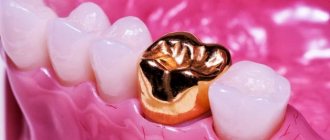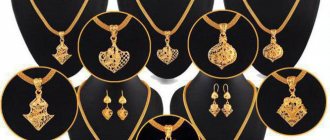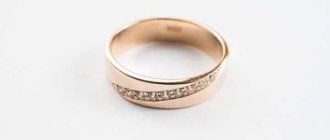Use of gold in dentistry
There are two ways to make such crowns: stamped and cast. For stamped ones, special blanks are made. Cast products are cast from gold using wax casts. They do not require any adjustment during installation because they already have a certain size. Cast products are more expensive than stamped ones, but in this case the tooth has to be ground much harder.
Dental crowns from 850 to 900 gold are used. In order for the prosthesis to be stronger, it is made not from pure gold, but with the addition of silver and copper.
Flaws
In addition to important advantages, gold crowns have several significant disadvantages:
- the plasticity of the material contributes to fairly rapid wear of the crowns as a result of regular intake of solid food;
- Low aesthetic indicators do not allow the use of this material for prosthetics of anterior teeth.
- has high conductivity, so over time the prosthetic tooth becomes more sensitive to hot and cold foods;
- when installing a product made of precious metal, tooth preparation is required for a tighter fit;
- gold structures have a higher cost compared to metal or ceramic counterparts.
Indications and contraindications
There are both indications and contraindications for the installation of such dental products. First of all, these are situations where it is possible to install only gold prostheses. Such cases include:
- the need to strengthen teeth;
- improving the aesthetic appearance of the row;
- restoration of teeth actively involved in the chewing process;
- the need to restore the previous shape of the tooth;
- Having a strong bite or teeth grinding habit.
There are a number of contraindications for installing gold crowns. It is not recommended to install them:
- under the age of 16;
- for diseases associated with the psyche;
- during pregnancy;
- with periodontitis.
If you are thinking about installing gold crowns to decorate your teeth, then stop. There is an easier way to decorate your teeth - grills:
Who can get gold crowns and who should choose another option?
Indications
Restoration of damaged dental units of the chewing group on the upper and lower jaw, complete restoration of their volume and functionality.
Contraindications
Presence of another metal in the mouth, age less than 16 years, pregnancy.
A little about galvanic electricity, or how to avoid the “battery in the mouth” effect
If there are prostheses made of iron, tin and its alloys in the mouth, and, for example, if you also install a gold prosthesis, electrochemical processes will begin, as in a finger-type battery. Plus is gold, minus is iron or tin, and saliva is a conductor. Galvanic electricity is generated, which does not have the best effect on health. Numbness and tingling in the mouth are not the most unpleasant consequences. Much more dangerous is chronic poisoning with metals, which under such conditions enter the blood.
Tooth preparation and crown installation
Preparation and installation of prostheses requires certain stages. For this process you need:
- Prepare the tooth. If caries is present, carry out special treatment and replace the filling.
- Before the procedure itself, the tooth should be numbed.
- The tooth is ground down on each side and adjusted to the thickness of the crown. It is given the required shape. Be sure to leave small ledges to secure the crown.
- The next step is taking impressions of the upper and lower dentition.
- A wax model is made using a plaster cast.
- The gold prototype is cast.
The patient is given a temporary crown, which remains in place until the gold one is made, since this process takes a certain time. It will protect the tooth from damage and destruction. After making a permanent crown, it is installed as follows:
- First, it is tried on and, if necessary, adjusted to the tooth.
- Before fixing it, check how tightly it fits and whether the teeth and the crown fit together correctly.
- The last stage is fixation with special dental cement.
Indications
Installation of crowns made on the basis of noble metal is indicated in the following cases:
- with pathological abrasion of enamel;
- if necessary, restore the anatomical shape of the tooth;
- to strengthen and restore the functionality of your own molars.
Find out the cost of tooth extension on a pin and in what cases this procedure is advisable. Read doctors' reviews about Ankylos implants here.
This address https://dr-zubov.ru/lechenie/zuby/kakie-prichiny-vedut-k-razrusheniyu.html contains material about the causes of tooth enamel destruction in children.
Advantages and disadvantages
Gold dentures have their pros and cons. Before deciding to install a gold crown on a tooth, you should study their advantages and disadvantages. The positive points include:
- beneficial effect of precious metal on teeth and microflora in the oral cavity;
- inertness of the metal in relation to the components of saliva and food;
- completely hypoallergenic;
- their ability to withstand any chewing load;
- quite a long lifespan, the durability of gold crowns with proper care can be extended to almost 15 years;
- protecting the tooth from caries, as gold has anti-inflammatory properties;
- inability to cause a destructive effect on the teeth in the opposite row at the junction of the jaws.
In the first days of installation, patients usually feel discomfort, which is not a disadvantage of the procedure. After a short period of time this condition will pass. The disadvantages of gold-plated teeth are:
- the softness of gold and gradual abrasion over time;
- very expensive installation, because gold itself is a precious metal;
- unaesthetic appearance of the front teeth.
A tooth with a crown and a living nerve becomes sensitive and reacts painfully to hot or cold food or drink, but this is a temporary phenomenon.
Such crowns are reused if they are in good condition, and they can also be sold or melted down.
Gold crowns
In the past, gold crowns were the most popular way to restore lost teeth. This was completely justified, because gold is one of the safest materials for the body. In addition, gold lends itself well to processing. Fortunately, now gold crowns are becoming a thing of the past, as more suitable materials for prosthetics have appeared. The main disadvantage of gold crowns is their appearance. They are completely different from natural teeth, so they have been replaced by other technologies. In the modern world, the aesthetic factor plays, if not the main, then one of the main roles when restoring dentition. Therefore, gold crowns are becoming a thing of the past.
They can usually be found in older people who had dentures installed many years ago. Judging by the appearance of the crowns, we can conclude that their service life is almost unlimited. In addition to durability, gold crowns have a number of advantages, such as compatibility with the human body, the absence of allergic reactions and irritation. In addition, gold is a fairly soft material, which ensures a tight fit to the dental tissues. As a result, bacteria do not get under the crown, which has a beneficial effect on the condition of the oral cavity. Be that as it may, gold and other metal crowns do not at all meet modern aesthetic requirements for the appearance of teeth. Therefore, they can hardly be recommended for installation on the front teeth. It is better to use ceramic or metal-ceramic crowns. But gold crowns can be used as a replacement for lateral chewing teeth.
The price includes all manipulations for manufacturing, installation and fitting, including taking impressions. Treatment is guaranteed for up to 3 years!
Sign up for a consultation
Indications for prosthetics with gold crowns
There are few individual indications for the installation of gold crowns. The main one is the factor of pathological abrasion of tooth enamel. To prevent abrasion, it is important to fix the height of the tooth, that is, the level where they meet each other. In this case, it is recommended to install crowns made of metals, in particular gold. At the same time, gold crowns are really one of the best options, since they take root well in the body. In other cases, it is recommended to install more modern ceramic or metal-ceramic prostheses. They are practically indistinguishable from natural teeth, do not cause injury to the gums and neighboring teeth, are durable and comfortable to wear. The use of gold crowns is not justified due to the high cost of the alloy, the rigidity of the material and the unpresentable appearance.
Another indication for the installation of gold crowns, which may seem strange and unusual, is the desire of the patient himself. Indeed, gold crowns and gold jewelry on teeth have recently become popular and fashionable. Some Hollywood stars wear gold linings and mouthguards encrusted with precious stones. Therefore, it is not surprising that other people also wanted to wear such unusual jewelry in their mouths.
Types of gold crowns
Gold crowns are not made entirely of gold because the metal is too soft. To strengthen the crowns, platinum and palladium are added to them. In order to give a more aesthetic appearance, dental crowns are covered with a layer of ceramic. Often the ceramic layer is applied only on the outside, which can lead to chipping. A more reliable way is to create metal-ceramic prostheses on gold, coated on all sides with a layer of ceramics. However, this is a completely different prosthetic technology that requires a separate discussion.
There are several types of gold crowns:
stamped: this technology is already outdated. It was popular at a time when there was no access to other prosthetic technologies in domestic dentistry. Stamped crowns are made from sleeves or metal plates made of gold alloy. The technology of prosthetics comes down to the following: the dentist takes an impression of the jaw, on the basis of which a plaster model of the tooth is created. The plaster model serves as a template for shaping the gold sleeve into the shape of a tooth. After this, the dental technician finalizes the crown, which will be installed in the patient’s mouth. This method has a number of significant disadvantages: the crown does not adhere tightly to the tissues, so food debris gets clogged under it, and plaque forms. The cement used to fix the prosthesis begins to dissolve after some time, which is a consequence of the formation of caries. The ends of the crown can damage the gums.
solid: high-precision monolithic casting technology is used here. Unlike the stamping method, such crowns follow the shape of the tooth and therefore do not injure the gums. In addition, due to the smoothness of the denture, plaque formation is reduced. Solid gold crowns are more durable than stamped ones, however, it is necessary to carry out a tooth preparation procedure before installing the prosthesis in the oral cavity.
Prosthetic technology
First of all, the oral cavity is prepared for prosthetics. The abutment tooth is turned and the nerve is removed. A gold prosthesis will be fixed to the supporting tooth. A dental crown is then created in the laboratory based on the impression and plaster model. The manufactured prosthesis is securely fixed on the abutment tooth, previously prepared for installation.
Advantages of gold crowns:
- protection against bacteria: gold alloys prevent the accumulation of dangerous bacteria under the crown. However, there is no substitute for good oral hygiene. You should not count on the fact that simply installing gold crowns will prevent the development of dental diseases;
- do not cause allergic reactions due to the fact that gold does not emit oxides, which are a common cause of irritation and allergies;
- gold crowns are highly durable and have incredible durability; they can last for years without any signs of deformation or destruction;
- gold crowns are softer than other types of metals, which not only ensures wearing comfort, but also allows the prosthesis to fit tightly onto the supporting tooth.
Disadvantages of gold crowns:
- high price;
- unpresentable appearance.
Alternatives to dental crowns
An alternative to gold crowns can be any modern prosthetic technology. For example, prostheses made of zirconium dioxide or metal ceramics. They are durable, reliable and attractive. Unlike gold crowns, they are almost impossible to distinguish from real teeth. Still, the main disadvantage of gold crowns is their unaesthetic appearance. Today there are not many people who want to install gold prostheses. Naturalness and naturalness are much more popular. Modern aesthetic dentistry offers many technologies that allow you to restore lost teeth. At the same time, dentures will provide comfort to wear and relieve psychological discomfort.
At the same time, today there is a really large selection of methods for restoring teeth. Visit a dentist for a consultation and he will definitely select the preferred type of crowns, taking into account the individual characteristics of your body and your financial capabilities.
Patient reviews
And I like gold teeth. This has always been considered an indicator of financial importance. I still have dentures from my grandmother; I can take them to a pawnshop. You just need to find out how to clean gold crowns from your teeth and check what kind of gold dental crowns are made of. But I wouldn’t put one on myself, because it’s unfashionable now.
Sergey, St. Petersburg
I am against gold teeth. They look unnatural. But last year I knocked out my front tooth during training. I went to the dental clinic and, as it turned out, not all dentures suit me. The dentist recommended inserting a gold tooth. I doubted it very much, but there were no other options for me. It turns out that they are placed for medical reasons. Especially if there are problems with the kidneys or liver.
In addition, gold dentures last about 15 years. You just need to take proper care of them. I asked what type of dental crowns are used. The doctor explained that gold teeth are of high standard and joked that this is a good investment.
Maxim, Nizhny Novgorod
Several years ago, on the recommendation of a doctor, I had gold teeth installed. It’s good that they are not front, so they don’t interfere with the aesthetics of the look. Gold interacts well with gums and does not cause discoloration. I didn't have any allergic reaction. I know that such teeth do not cause any negative reaction in the body. They are placed if the patient has significant stomach problems. Coated teeth often cause various complications.
However, I think that from time to time it is necessary to take pictures to make sure that everything is in order with the teeth.
It's just for insurance. And so they will serve for at least 10 years, or even more. Marina, Orel
Advantages
Precious metal has long established itself as a reliable and durable material for dental prosthetics. The undeniable advantages of using gold include the following:
- biological compatibility of the material with human tissues does not cause an allergic reaction or darkening of adjacent teeth;
- gold is not subject to corrosion, so such crowns do not oxidize under the influence of saliva and food;
- the high strength coefficient of gold eliminates the possibility of chips and cracks forming on the surface of the crown;
- the material is resistant to high loads when chewing food, which is why it is often used in molar prosthetics;
- the softness and plasticity of the metal makes it possible to produce crowns in accordance with the anatomical shape of the tooth being prosthetized, ensuring its tight fit to the supporting tissues;
- does not cause galvanic syndrome, therefore such crowns are compatible with other metals present in orthodontic structures;
- the products have a long service life - with regular care they last up to 20 years;
- Gold ions have a beneficial effect on the microflora of the oral cavity, penetrating into the digestive tract with saliva and having an anti-inflammatory effect.
Introduction
When carrying out complex dental rehabilitation, very high demands are placed on the quality of manufactured restorations. They must be stable, functionally efficient, precise and made from high quality materials. Another important quality criterion, which is of decisive importance for many patients, is aesthetics. This term is widely used in our professional environment, but most often very pragmatically, to emphasize certain advantages of the manufactured restoration. At the same time, no one can clearly explain what aesthetics actually is. This concept does not have a clear definition and its content is highly dependent on fashion, age, social environment and many other factors that have nothing to do with dentistry.
In short, for us aesthetics means:
- beauty and functionality of each tooth,
- harmonious combination of individual elements with each other,
- harmonious combination of restoration with lips, face and individual features,
- beautiful and natural appearance overall.
The answer to the question of what materials and technologies can be used to satisfy these requirements depends greatly on the size of the restoration. It is recommended to make single crowns of teeth in an aesthetically significant area from ceramics, since all-ceramic restorations have optimal optical properties close to the properties of natural teeth. For chewing teeth, metal, metal-ceramic and all-ceramic crowns based on zirconium dioxide can be made.
During complex sanitation, there are no natural teeth with which restorations can be compared, so the best option, of course, is metal-ceramics. The stability and precision of restorations is ensured by a metal frame, and the aesthetic characteristics are formed by facing ceramic materials, the properties of which have been brought to near perfection over the past decades.
Metal-ceramic restorations are widely used in daily practice. Many dental technicians have perfected the technology for their production to the point of automation. Fitting, mechanical correction and cementation of such restorations usually does not cause any problems. That is why in this case we decided to make stable, reliable and beautiful metal-ceramic restorations for our patient.
Reviews
Gold crowns are often used in dental practice due to their strength and reliability.
At the same time, in terms of aesthetic indicators, these products are inferior to metal-ceramic and zirconium analogues.
Sources:
- https://mnogozubov.ru/zolotye-koronki-na-zuby/
- https://esculapdent.ru/services/zolotye-koronki
- https://dr-zubov.ru/ortopediya/nesemnye-protezy/koronki/sovremennye-raznovidnosti-zolotyx.html
- https://www.vash-dentist.ru/protezirovanie/nesemnyie-p/koronki-np/zolotyie.html
- https://stoma.click/ortodontia/protezi/zolotye-koronki.html
- https://AcademiaDent.ru/info/zolotye-koronki-na-zuby/
- https://me-dent.ru/protezirovanie/koronki/vstavit-zolotoj-zub
- https://protezi-zubov.ru/koronki/zolotye/










